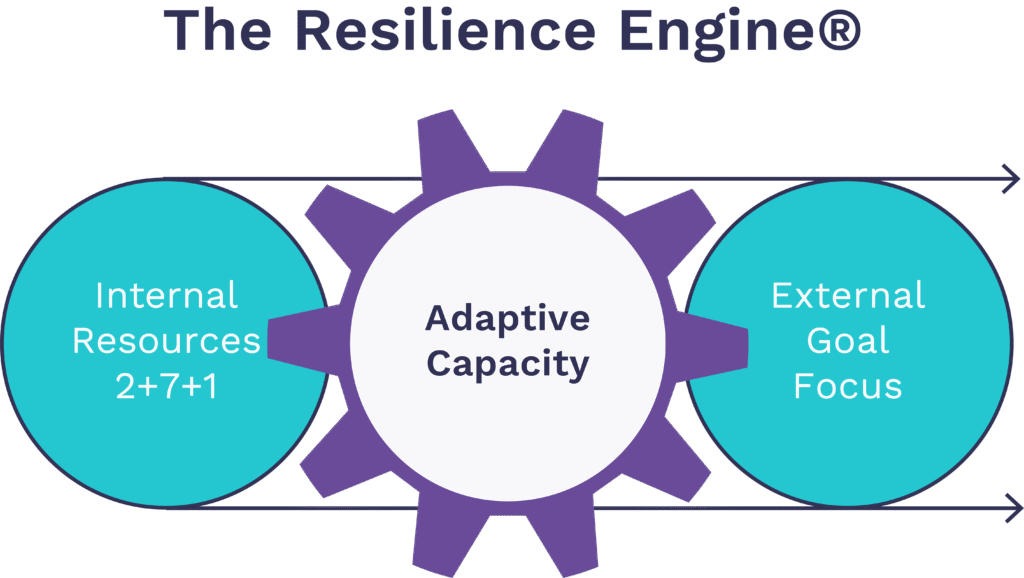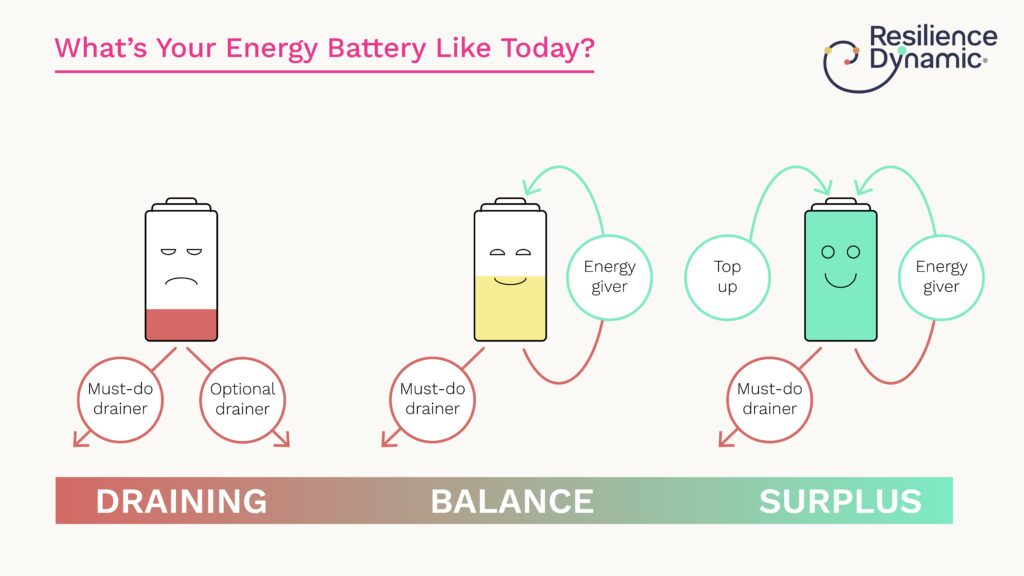Rest and Recovery Are Not Luxury – They’re Performance Multipliers
You may be ignoring a truth: performance is not driven by perpetual effort but by the capacity to restore. You don’t just need more focus; you need strategic restoration through rest and recovery.
These two terms are often used interchangeably. From our research at The Resilience Dynamic, we know that rest and recovery play distinct but equally essential roles in enabling your resilience, aka your adaptability. They are strategic must-have’s for anyone who leads, whether in the workplace or elsewhere.
Rest vs Recovery: Not the Same Thing
Rest is the pause. It’s the disengagement. Rest is passive. It is a temporary shift away from active demands, allowing your system to settle and return to your baseline. When you rest, your nervous system transitions from sympathetic (fight or flight) to parasympathetic (rest and digest) mode. Your cortisol levels drop, your muscles soften, you feel more calm, and your prefrontal cortex that I have written about before gets a chance to reset (Porges, 2011).
Neurologically, rest—especially quality sleep—supports cognitive integration, memory consolidation, and emotional regulation (Walker, 2017). Without adequate rest, you lose access to the executive functions. If you are a leader reading this, without rest, you lose empathy, decision-making capabilities, and disconnect from your vision.

Recovery, by contrast, is the intentional process of replenishing depleted energy—physical, emotional, mental, and spiritual. Where rest stops the drain, recovery refuels the tank. It involves active choices: sleeping deeply, moving your body, connecting with people and things that nourish you, spending time in nature, or engaging in reflection and learning. If you chronically under-recover, you end up in a deficit you can’t think your way out of.
Both rest and recovery are essential; one does not replace the other. When you confuse rest for recovery, you may pause—but not rebuild. When you confuse recovery for rest, you may work harder at recharging than necessary.
Key insights from the science on rest and recovery are below.
- Rest helps your brain return to baseline, reducing cortisol and supporting executive function (Sapolsky, 2004).
- Deep sleep (especially non-REM sleep) flushes toxins from your brain and aids memory consolidation (Walker, 2017).
- Recovery practices like nature exposure and physical movement stimulate neurogenesis and emotional regulation (Berman et al., 2008).
- Heart rate variability (HRV) increases during true recovery, indicating that your system is balanced and adaptable (Thayer et al., 2012).
If you find yourself doing all the ‘right things’ but still feeling fatigued, you might therefore ask yourself ‘am I truly investing in recovering’?
The table below sums this difference up:
Distinguishing Rest and Recovery
| Rest | Recovery | |
| Function | Pause and regulate | Rebuild and regenerate |
| Mode | Passive or non-demanding | Active and intentional |
| Focus | Nervous system calming | Energy replenish |
| Examples | Napping, silence, breathwork | Sleep, movement, reflection, learning, connection, reconnection to purpose |
The Resilience Dynamic Model and Recovery
The Resilience Dynamic research reveals that resilience is not a fixed trait. You are not either resilient or not—your resilience varies by context, dynamically changing according to your energy, perception, and environment.
What we have discovered in our research is that your resilience state is heavily influenced by your capacity to recover. In fact, one of the most consistent differences between people with high versus low resilience is the quality of their recovery strategy, not just their mindset or motivation. It is summed up in the ‘Adaptive Capacity’ element of the Resilience Engine®, our model that describes how to build resilience.

You may have been encouraged to “push through” or “dig deep.” And sometimes, that’s needed. But sustainable resilience comes not from pushing harder, but from knowing when to pause, and how to refuel.
Resilience Dynamic coaches use two principle metaphors for helping clients see the importance of rest and recovery. The first is the Resilience River ©, and the second is the Energy Battery©.

Whilst energy is only one of the key drivers of resilience ie your adaptability, it is a good first stage proxy for noticing and learning what is going on. The key is when you draw down your reserves without replenishing them, your energy battery runs dry. But when you integrate recovery habits, even in small ways, you increase your resilience range. That’s the key: resilient people don’t just double down, or even just bounce back—they deliberately enhance their range of responses.
Rest and Recovery for Leaders and High Performers
If you’re in any kind of leadership role, whether in work or in your personal life, and aiming to work at a high level, you might be especially at risk of under-recovery.
Culturally, we reward ‘bounce-backers’! These are people who take on challenge and aim to punch through, no matter what’s going on. It drives a culture of ‘always on’, ‘busy-busy-busy’, and keeps people in performance mode. Activity and effort become undeniable expectations, regardless of impact. Overall, our workplaces continue to value ‘visible productivity’. But in truth, the most adaptive, creative, and resilient leaders have strong rest and recovery strategies, and these are embedded into both work and personal life.
Resilience Dynamic coaches support leaders to transform their organisations, not by doing less but by creating dynamic pacing according to the demands ahead versus the capacity of their people right now. For themselves individually, they learn to schedule rest and recovery as rigorously as any work tasks. It becomes part of their daily habit.

Performance Multipliers in Practice
Here are some thoughts for how you might build rest and recovery into your daily habit:
- Schedule Recovery, Not Just Meetings: Protect blocks in your week for renewal—whether that’s deep breathing, walking, or structured coaching.
- Shift Your Story: Move from “I don’t have time to rest” to “rest is part of how I deliver.” Reframe rest and recovery as ROI, not reward.
- Use Micro-Rest: The brain benefits from even 1–3 minute resets. Try the 20-20-20 rule: every 20 minutes, look 20 feet away for 20 seconds.
- Track Energy, Not Just Tasks: Use reflection tools to notice where your energy lifts or drains. Recovery begins with awareness.

Final Words! Reclaiming Rest and Recovery Is Not Radical But Sensible!
Rest and recovery are not the opposites of performance. They are its prerequisites.
In today’s world that continues to worship busy-busy-busy, reclaiming your resilience through rest and recovery might feel like a radical act. But it’s just common sense, working with how your mind and body are wired. Building recovery into your daily and weekly rhythm is already part of your innate wisdom. Why would you not unleash it for yourself and on behalf of others?
If you are interested in working with the Resilience Dynamic, please don’t hesitate to get in touch via [email protected].
References
Berman, M.G., Jonides, J. and Kaplan, S., 2008. The cognitive benefits of interacting with nature. Psychological Science, 19(12), pp.1207–1212.
Campbell, J., 2019. The Resilience Dynamic: The Key to Unlocking Your Natural Resilience for Thriving in a Complex World. Edinburgh: Resilience Dynamic.
Porges, S.W., 2011. The Polyvagal Theory: Neurophysiological Foundations of Emotions, Attachment, Communication, and Self-Regulation. New York: W.W. Norton.
Sapolsky, R.M., 2004. Why Zebras Don’t Get Ulcers. 3rd ed. New York: Henry Holt & Company.
Thayer, J.F., Åhs, F., Fredrikson, M., Sollers III, J.J. and Wager, T.D., 2012. A meta-analysis of heart rate variability and neuroimaging studies: implications for heart rate variability as a marker of stress and health. Neuroscience & Biobehavioral Reviews, 36(2), pp.747–756.
Walker, M., 2017. Why We Sleep: Unlocking the Power of Sleep and Dreams. London: Penguin.
If you would like to explore more about ‘The 65/35 Rule’ for yourself or your own team, look at the following resources:

Author: Jenny Campbell Founder and CEO of the Resilience Dynamic
Follow Jenny on LinkedIn for more of her thoughts, resilience research, and ideas.
Gain exclusive access to Resilience Dynamic in-depth insights
Extend your knowledge, expand your thinking into Healthy, High Performance.
Register today and get your free login to:
- Gain exclusive access to in-depth resilience insights.
- Download and share the insights with your friends and colleagues.
- Receive resilience in-depth insights and tools straight to your inbox, every month.
If you are already receiving our resilience tools via email but it's the first time seeing this exclusive access, do register. You'll get the new exclusive insights, plus be able to download all articles. Simply complete this registration form once to get your login details.
Read our privacy policy
